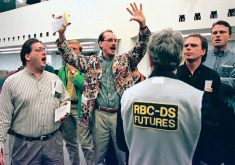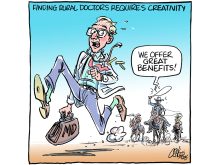Canada’s cattle producers have climbed back to profitability after a long struggle to reorganize after the BSE crisis.
Safeguards such as Specified Risk Material removal, tagging, age verification and monitoring are now in place and are winning back export markets.
Producers in Canada and the United States have reduced herds and the combination of smaller calf crops and improved exports has led to record high beef prices and strong cattle prices this summer.
It marks a point where the industry can congratulate itself for an innovative and hard fought response to a crisis and start to get ready for herd rebuilding.
Read Also

Kochia has become a significant problem for Prairie farmers
As you travel through southern Saskatchewan and Alberta, particularly in areas challenged by dry growing conditions, the magnitude of the kochia problem is easy to see.
But some analysts warn it might not be fair winds and steady sailing.
The cost structure of the North American cattle industry has risen considerably with what appear to be permanently higher feed and fuel prices, as well as the costs associated with the BSE recovery system.
Beef demand is in long-term decline in North America. Per capita beef consumption in 2010 in the U.S. was 59.7 pounds. That broke the old low of 59.8 lb. set in 1958 and was 1.4 lb. lower than the level of 2009.
Meanwhile, chicken demand continues to grow thanks to its efficiency in converting grain to meat, relatively low cost and product innovation.
Canadian demand figures are similar.
The demographic bulge that is the baby boom will also affect demand. Boomers are reaching their retirement years when they will tend to eat less than younger people.
There are additional challenges associated with a beef herd that is about the smallest in 50 years. Packing plants and feedlots are operating below capacity and that is highly inefficient.
In the past few years, several packing plants closed in Canada and the United States and observers such as Darrell Mark of the University of Nebraska-Lincoln worry that the small number of animals being fed and going to slaughter could lead to more closures.
When the rebuilding herd starts to turn out more market cattle in a few years, will there be feeders and packers to process them and will North American consumers be ready to buy more beef?
Another analyst, Bill Helming, former chief economist for the National Cattlemen’s Beef Association, warns that new strategies are needed to confront beef’s high cost.
Henning Steinfeld, an official with the United Nations’ Food and Agriculture Organization, last year suggested that beef could become the caviar of the future, affordable only by the rich.
Helming said that increasingly, North Americans consume their beef as hamburger because of its convenience and lower cost.
This trend could increase in the next few years as America struggles with high unemployment, a huge debt and weak economy.
While a little more than half of ground beef comes from cull and dairy cows and imports, 45 percent of fed cattle wind up as ground meat.
However, the beef industry feeds almost all cattle as though they were going to produce only high end steaks and roasts.
Helming suggests three streams of production matched to markets: grass-fed animals for hamburger, a combination of grass and short-term feeding and full grain feeding for quality cattle destined to produce high value cuts.
That would reduce the overall cost of the industry and help it compete against chicken and pork.
This is out of the box thinking and would require research before engaging in such a radical restructuring.
But with production cost and demand challenges facing the industry, it must keep its eye on the future and be prepared to innovate again.
Bruce Dyck, Terry Fries, Barb Glen, D’Arce McMillan and Joanne Paulson collaborate in the writing of Western Producer editorials.
















